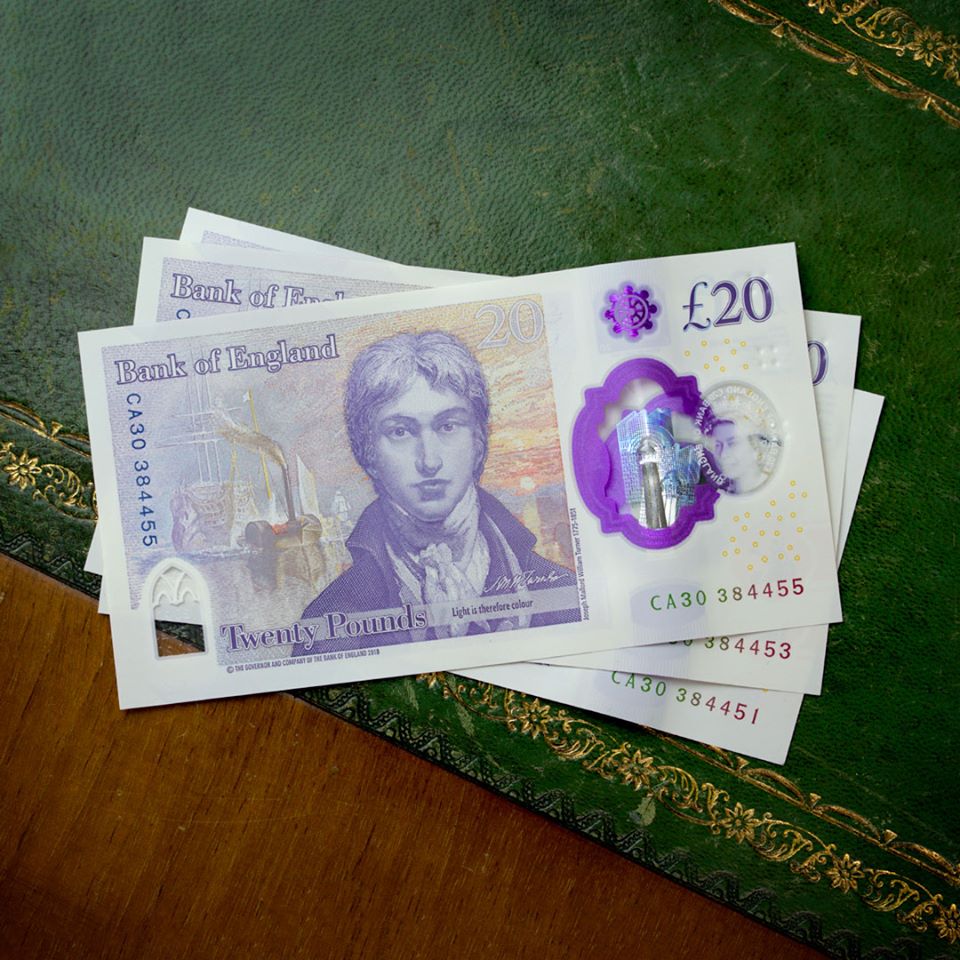Which JMW Turner £20 notes should you be looking out for?
The polymer £20 note has been in circulation for over a year now and we’ve certainly been enjoying seeing them being exchanged!

This is the third polymer banknote to be released in the UK, following the release of the polymer Churchill £5 in 2016 and the polymer Jane Austen £10 note in 2017.
Keen collectors have eagerly been hunting down the most sought-after serial numbers for the new note.
When the UK’s first polymer £5 note was released in September 2016, serial numbers became the talk of a nation and stories of early serial numbers selling for thousands of pounds were commonplace.
In fact, an “AK37 007 James Bond Bank of England Polymer £5 note” even sold for £5,000 on eBay – 1,000 times its face value!

But as we await the release of the new note on the 20th of February, which serial numbers should you be looking to get your hands on?
AA01 – the first notes to be printed
AA01 are the first serial numbers to be printed and always prove popular with collectors.
Our eBay Tracker follows the prices of the UK’s Top Coins and Banknotes, including the AA01 polymer £5 and £10 notes, which are currently selling for £10 and £15 respectively. However when the notes were first released we saw a collecting frenzy, with people paying (and demanding) vastly inflated prices for low serial number notes.
Prefixes on the £5 notes started at AA and there are 60 notes on a sheet, AA01- AA60. For each of these cyphers there are 999,000 serial numbers printed: 000001 to 999000. Therefore for the first AA cypher there’s an incredible 59,940,000 notes!
Whilst the £20 note is larger than the £5, meaning less notes will be printed per sheet, there are still A LOT of combinations for AA cyphers on the new £20 – so make sure you keep your eyes out for them!

However, The Bank of England will always hold back some of the notes with the earliest serial numbers, donating them to people or institutions that were involved in the development of the note or who traditionally receive a note when a new series is issued.
For example, the Queen receives AA01 000001 and for the release of the £5 note the Churchill War Rooms received one with serial number AA01 001945, the date that WWII ended.
Key dates to look out for
It’s always worth looking out for certain serial numbers matching key dates relating JMW Turner that could become collectable.
For example, 23 041775 represents Turner’s date of birth, whilst 19 121851 relates to his death and 17 751851 would be his birth and death combined.
True Turner fans might also look for 18 381839 representing the date he painted ‘The Fighting Temeraire’ (featured on the new £20 note) and the date the painting was exhibited at the Royal Academy respectively.

Novelty numbers and Consecutive notes
There may well also be a rush to find the AK47 serial numbers again and James Bond 007 will likely be popular once more.
Consecutively numbered notes are always interesting to collectors too – one man sold three consecutive AA01 notes for £456!
Q&A
Can you request specific serial numbered notes from the bank?
Sadly not. For the launch of the new £5 note 440 million banknotes were printed and these were printed in very large batches.
There will be even more new £20 notes printed than the £5, to service the country’s 48,000 ATMs for example, so it’s just not possible for the bank to separate certain serial numbers.
How much should I pay for a new £20 note?
The simple answer is, it’s completely up to you. An early serial numbered £20 note will be a genuine piece of the country’s history. It’s likely The Bank of England will hold an auction of early editions, so if you have the disposable income, why not?!
Will the old paper £20 note still be legal tender?
You will still be able to use the paper £20 note until The Bank of England withdraw it from circulation. This will be announced after the new note has been issued and they will give six months’ notice of the withdrawal date.
Many banks will accept withdrawn notes as deposits from customers. The Post Office may also accept withdrawn notes as a deposit into any bank account you can access at the Post Office. And, you can always exchange withdrawn notes with The Bank of England directly.
Where will I be able to find the new polymer £20 note?
We will be publishing a list of locations where the polymer £20 note will be available on the 20th, when the new note is released.
With the brand new Alan Turing £50 set to be released on June 23rd, it’s important to refresh your memory on which serial numbers are worth looking out for…
Will you be looking out for any particular serial numbers? Let us know in the comments below!
Own one of the first £1 banknotes issued since decimalisation in 1971 in mint uncirculated condition!
This £1 banknote, which is in mint uncirculated condition, was issued by The Bank of England in 1978-1981. It was part of the Series D Pictorial Issue series of £1 banknotes, and was the first £1 banknote issued since decimalisation in 1971.





It says AK37 instead of AK47.